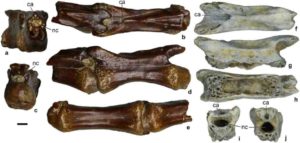
Bones from an Alvarezsaurid dinosaur were discovered in Uzbekistan and could shed light on the evolution and origin of the species, according to a study published October 25, 2017 in the open-access journal PLOS ONE by Alexander Averianov of Zoological Institute of the Russian Academy of Sciences, Russia and Hans-Dieter Sues of the Smithsonian Institution, USA.
Previous studies have described Alvarezsauridae as small, long-legged, bipedal dinosaurs with short forelimbs that featured bird-like hands. Since Alvarezsaurid remains are extremely rare, there is plenty to learn about the evolution of this species.
The authors of this study analyzed previously excavated Alvarezsaurid remains from the Turonian Bissekty Formation of Uzbekistan. They examined the vertebrae, the bird-like bone that fuses the wrist and knuckle known as the carpometacarpus, and pieces of what would be the fingers or toes, known as the phalanx. They then measured and compared the shapes and sizes of these bones with those from similar species from the literature.
The authors state that the characteristics for the Alvarezsaurid bones are so distinctive that it could be identified just from the seven bones collected at the Bissekty Formation. These distinctive features included rounded vertebrae located close to the tail, a large and depressed second metacarpal, and a robust second digit with a claw-like end.
While there are competing theories about where the Alvarezsaurid originated, the authors suggest that the discovery of an Alvarezsaurid at this site in Uzbekistan indicates that this group had an evolutionary history in Asia and provides evidence that this continent could have been where the clade originated.
Lead author Hans Sues says: “Our paper reports the discovery of the earliest known alvarezsaurid dinosaur from the Northern Hemisphere, based on 90-million-year-old fossils from Central Asia. Alvarezsaurids were unusual small predatory dinosaurs that had very short but powerfuly built arms that ended in a single large digit.”
Reference:
Alexander Averianov, Hans-Dieter Sues. The oldest record of Alvarezsauridae (Dinosauria: Theropoda) in the Northern Hemisphere. PLOS ONE, 2017; 12 (10): e0186254 DOI: 10.1371/journal.pone.0186254
Note: The above post is reprinted from materials provided by PLOS.










